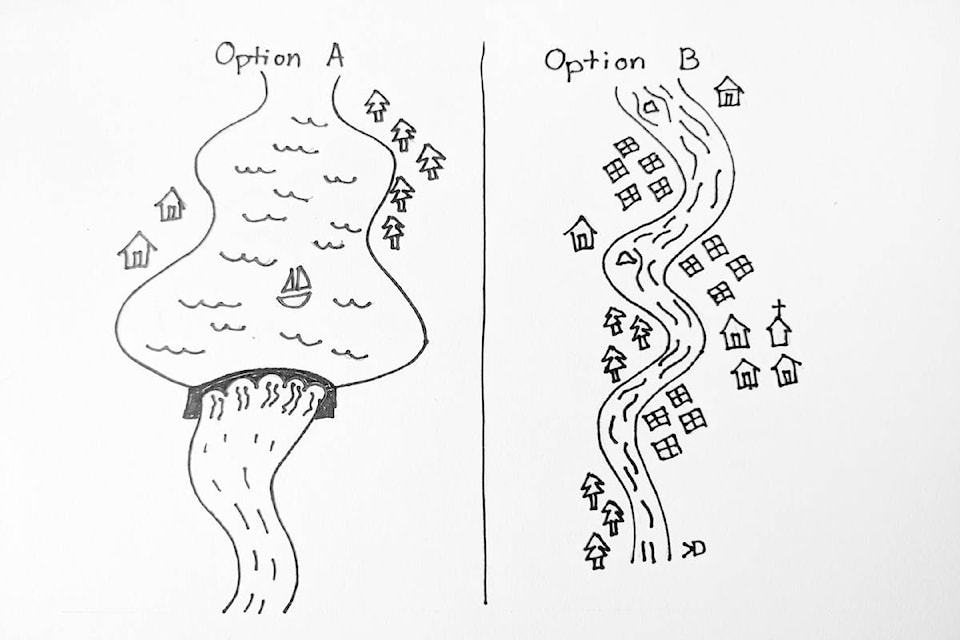British Columbia is a great place to drive an electric vehicle. Why? Most of our electricity comes from hydroelectric dams (but not most of our energy, see sa���ʴ�ý�Donsa���ʴ�ý�t get too smug about B.C.sa���ʴ�ý�s hydroelectricsa���ʴ�ý�
But dams, once the go-to source of low carbon electricity, are problematic from an environmental perspective.
We know that dams cause extensive ecological damage to the flora and fauna overrun by the reservoir. Dams also produce more methane and CO2 than was previously suspected. Rotting materials, deep underwater without access to oxygen, break down. This produces large amounts of methane and CO2. The methane is 30 times more powerful a greenhouse gas than CO2.
Reservoirs created by dams trap rotting material deep underwater, producing methane, a greenhouse gas 30 times as powerful as CO2
This sa���ʴ�ý�carbon costsa���ʴ�ý� is much higher than emission from natural lakes or marshes; the emission from dams is much closer to human-created water bodies such as rice paddies. The Site C dam is expected to emit between 4-6 million tonnes of CO2 equivalent over a 100-year operating life, with most emissions occurring within 10 years after the flooding.
READ MORE:
Given a critical need to switch to low carbon power, what are the alternatives to the environmental impact of hydro power? Ask John Waldman. In research published in the scientific journal sa���ʴ�ý�Nature Sustainabilitysa���ʴ�ý�, Waldman (along with Shailesh Sharma, Shahab Afshari and Balázs Fekete) conducted a thought experiment: What if you removed the dam, and used some of the area now underwater for photovoltaic panels?
The first question: Is it possible to generate enough energy by replacing reservoirs with solar farms? The answer is a resounding sa���ʴ�ý�yessa���ʴ�ý�. In fact, given the efficiency of solar panels today, you need less room for photovoltaics than you would cover with water for a dam.
The idea of restoring habitats flooded by reservoirs, and replacing the clean energy by putting up some solar panels is striking. What is even more impressive is that after we do the math, it turns out that we only need 13% of the land area flooded by dams to create the same amount of electricity.
Research by Waldman shows that we could replace all the electricity coming from dams by using 13% of the reservoir land area for solar energy
READ MORE:
It would be premature to start dismantling all of our dams. Many dams have other uses, such as controlling flooding and providing drinking water. Dams also play two critical roles in maintaining our electricity grid: serving as sa���ʴ�ý�dispatchable energysa���ʴ�ý� and as a key sa���ʴ�ý�black-startsa���ʴ�ý� resource. First letsa���ʴ�ý�s talk about sa���ʴ�ý�peaker plantssa���ʴ�ý�. The amount of electricity we need changes during the day and is not completely predictable. In order to meet a sudden spike, you need a source that can respond quickly sa���ʴ�ý� this is called sa���ʴ�ý�dispatchablesa���ʴ�ý� energy. In the table we list sources of electricity that can and cannot react quickly to demand. Hydro and natural gas, marked with an asterisk, are considered the best source of dispatchable energy.
Hydro and natural gas are considered the most sa���ʴ�ý�dispatchablesa���ʴ�ý� resources.
In the event of a widespread power outage, some plants can restart themselves, while others require electricity to start producing electricity. The ability to do this makes them a sa���ʴ�ý�black-startsa���ʴ�ý� resource. Hydro is often designated, coming online and then providing electricity to fossil-fuel or nuclear stations. (Here technology is changing things. In California they have tested a battery storage system, to provide a black-start to a natural gas plant. Clearly solar+storage could play an important role.)
READ MORE:
The Waldman and collaborators thought experiment is useful in two ways. First it demonstrates that photovoltaics are not only capable of replacing hydro energy, but if you consider the environmental sa���ʴ�ý�footprintsa���ʴ�ý� they would be a significant improvement. Secondly it suggests that as our ability to store solar power matures, we could consider replacing hydro power with photovoltaics.
Finally, we live in a world where people use electricity but donsa���ʴ�ý�t want it generated anywhere near them. People protest strongly because they oppose any generation in their backyard (nuclear, wind, coal, solar). If we frame the question, not sa���ʴ�ý�can we put a powerplant heresa���ʴ�ý� but sa���ʴ�ý�which power plant would be least disruptivesa���ʴ�ý� then solar clearly winds over hydropower.
Missed the last column?
Kristy Dyer has a background in art and physics and consulted for Silicon Valley clean energy firms before moving (happily!) to sunny Penticton. Comments to Kristy.Dyer+BP@gmail.com
Kristysa���ʴ�ý�s articles are archived at
Like us on and follow us on .



